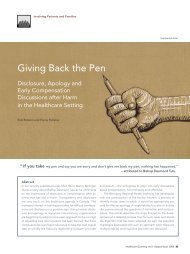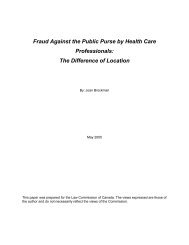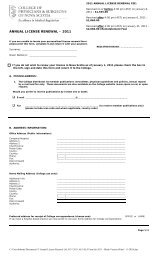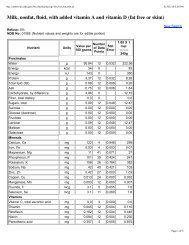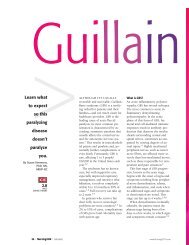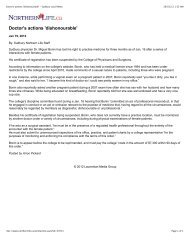Experiments That Changed Nutritional Thinking - TUUM EST
Experiments That Changed Nutritional Thinking - TUUM EST
Experiments That Changed Nutritional Thinking - TUUM EST
Create successful ePaper yourself
Turn your PDF publications into a flip-book with our unique Google optimized e-Paper software.
1032S<br />
SUPPLEMENT<br />
TABLE 2<br />
Literature Cited<br />
Mean 3-wk weight changes of young rats receiving 18% zein<br />
Abderhalden, E. (1909) Weiterer Beitrag zur Frage nach der Verwertung von<br />
tief abgebautem Eiweiss in Tierischen Organismus. Z. Physiol. Chem. 61:<br />
as their protein source1<br />
194–199.<br />
Becker, S. (1968) The Emergence of a Trace Nutrient Concept through Animal<br />
Feeding <strong>Experiments</strong>. Ph.D. thesis, University of Wisconsin. University Micro-<br />
Amino acid<br />
films Inc., Ann Arbor, MI.<br />
supplement to diet Mean weight Carpenter, K. J. (1994) Protein and Energy: A Study of Changing Ideas in Nutri-<br />
No. rats (g/100 g) change ({SD) tion. Cambridge University Press, New York, NY.<br />
Chittenden, R. H. (1938) Lafayette Benedict Mendel, 1872–1935. Natl. Acad.<br />
g<br />
Sci. Biogr. Mem. 18: 123–155.<br />
Fruton, J. S. (1995) Thomas Burr Osborne and chemistry. Bull. Hist. Chem.<br />
17: 1–8.<br />
22 None 020 ({ 5)<br />
Henriques, V. & Hansen, C. (1905) Über Eiwessynthese im Tierkörper. Hoppe-<br />
6 0.54% Tryptophan 07 ({ 6) Seyler’s Z. Physiol. Chem. 43: 417–446.<br />
7 0.54% Tryptophan /22 ({ 5) Osborne, T. & Mendel, L. B. (1911) Feeding <strong>Experiments</strong> with Isolated Food<br />
/ 0.54% lysine Substances. Carnegie Inst. Washington. Publ. 156.<br />
[Normal weight gain on a control diet] [/35]<br />
Osborne, T. & Mendel, L. B. (1914) Amino-acids in nutrition and growth. J.<br />
Biol. Chem. 17: 325–349.<br />
Osborne, T. & Mendel, L. B. (1916) The amino-acid minimum for maintenance<br />
1<br />
and growth, as exemplified by further experiments with lysine and trypto-<br />
Data from Osborne and Mendel (1914).<br />
phane. J. Biol. Chem. 25: 1–12.<br />
Vickery, H. B. (1932) Thomas Burr Osborne, 1859–1929. Natl. Acad. Sci. Biogr.<br />
with gliadin as the sole protein, lysine did not seem to be Mem. 14: 261–304.<br />
Willcock, E. G. & Hopkins, F. G. (1906) The importance of individual amino<br />
acids in metabolism. J. Physiol. 35: 88–102.<br />
required for maintenance. However, by 1915, with an improved<br />
analytical procedure for lysine, they had found that<br />
gliadin did contain about 0.9% lysine, but they assumed that<br />
Paper 9: Pellagra Is Not Infectious!<br />
the rat’s muscle proteins, like those of animals’ muscles that<br />
(Goldberger, 1916)<br />
had been analyzed, contained approximately 8% lysine, so that<br />
part of the lysine in the rats’ new tissues had to have come<br />
from the free amino acid supplement. They did not report any<br />
actual calculations to support this point, but Table 1 reproduces<br />
the relevant estimates that they could, and perhaps did,<br />
make.<br />
Lysine could not apparently by synthesized by rats, even<br />
though it had no cyclic group. This was an important point<br />
because it had been thought it was the amino acids containing<br />
cyclic groups that animals would be found to be unable to<br />
synthesize. On the other hand, rats could apparently maintain<br />
themselves with dietary protein of very different composition<br />
from that of their own tissues.<br />
This idea was confirmed by their parallel results with zein<br />
(from corn), which is completely lacking in lysine and also<br />
both tryptophan and glycine (Osborne and Mendel 1916).<br />
They showed most of their results with zein as growth curves<br />
for individual rats, because they changed their supplements<br />
from time to time, but Table 2 summarizes their results from<br />
just the first few weeks of feeding.<br />
It is clear that without tryptophan the rats did worst. With<br />
it, but without lysine, they did better, though on average still<br />
losing a little weight. With both amino acids added, they grew<br />
fairly rapidly, at about two thirds of the optimal rate. They<br />
concluded, as Willcock and Hopkins (1906) had earlier, that<br />
perhaps the more rapid loss in the absence of tryptophan meant<br />
that this amino acid was needed for some special priority function,<br />
requiring tissue loss to provide it, and that in its presence<br />
there was at any rate less breakdown of protein.<br />
The work clarified the importance of amino acid composition<br />
as a determinant of protein quality and demonstrated<br />
examples of three types of amino acids: lysine that could not<br />
be synthesized and was needed almost entirely for growth,<br />
tryptophan needed for maintenance as well as growth, and<br />
glycine that could be synthesized so that its supply was not<br />
limiting.<br />
Osborne and Mendel’s persistence with long-term growth<br />
as a measure of nutritional adequacy, in parallel with the work<br />
of McCollum’s group in Wisconsin, opened up a new approach<br />
to the search for vitamins as well as the discovery of further<br />
essential amino acids (Becker 1968, Carpenter 1994).<br />
Presented by Leslie M. Klevay, U.S. Department of Agriculture,<br />
Grand Forks Human Nutrition Research Center, Grand Forks,<br />
ND 58202 and Robert E. Olson, College of Medicine, University<br />
of South Florida, Tampa, FL 33606 as part of the minisymposium<br />
‘‘<strong>Experiments</strong> <strong>That</strong> <strong>Changed</strong> <strong>Nutritional</strong> <strong>Thinking</strong>’’ given at Experimental<br />
Biology 96, April 16, 1996, in Washington DC.<br />
Microbiology was transforming medicine at the end of the<br />
Victorian era. By the time Funk coined the term ‘‘vitamine’’<br />
in 1912, the causative organism for tuberculosis had been<br />
known for 30 years. It is not surprising that infection was<br />
considered more likely than dietary deficiency to be the cause<br />
of pellagra. Both toxicity and heredity, two other causes of<br />
disease known at the turn of the century, had also been suggested.<br />
Dementia, dermatitis, diarrhea and finally death associated<br />
with a diet of meat, maize and molasses described the pellagra<br />
syndrome. Unfortunately, the ‘‘meat’’ consumed by poor people<br />
was high in fat and low in protein. The dermatitis is photo-<br />
sensitive and confined to the areas of skin exposed to sunlight;<br />
Cásal’s (1691–1759) necklace is the eponym attached to ‘‘the<br />
area of erythema and pigmentation around the neck in pellagra’’<br />
(Terris 1964). The dementia was usually of the manic-<br />
depressive type and severe enough to justify admission to a<br />
mental institution.<br />
Joseph Goldberger, who contributed extensively to our understanding<br />
of the causes of pellagra, was born in Austria in<br />
1874 and immigrated with his parents to the United States in<br />
the 1880s. He grew up in New York City and entered the City<br />
College of New York as a high school graduate in 1890 to<br />
study engineering but changed his field to medicine two years<br />
later by enrolling at the Bellevue Hospital Medical College.<br />
He obtained his MD degree in 1895 and after interning for<br />
one year and practicing medicine in New York and Pennsylvania<br />
for three additional years, he joined the U.S. Public Health<br />
Service in 1899. He served as a quarantine officer in various<br />
ports including New Orleans, Tampico, Veracruz and Havana<br />
and studied yellow fever and typhus transmission by mosquitos<br />
in those areas. In 1909, he solved the cause of Schamberg’s<br />
disease, a pigmented dermatitis, prevalent in crew members<br />
/ 4p09$$0062 04-07-97 14:02:12 nutras LP: J Nut May Suppl<br />
Downloaded from jn.nutrition.org by on June 3, 2010



